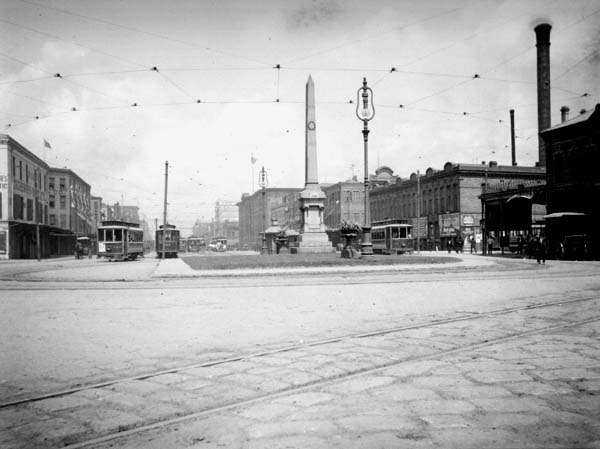On this date in 1891...
A lengthy jury selection process concluded Friday, February 27, 1891, and the trial of nine men accused of the assassination of New Orleans Police Chief David Hennessy began with the reading of the indictment by Court Clerk Richard Screven.
Screven read:
The grand jurors of the State of Louisiana, duly impaneled and sworn in and for the body of the Parish of Orleans, in the name and by the authority of the said state, upon their oath, present:
That one Peter Natali, one Antonio Scaffidi, one Antonio Bagnetto, one Manuel Politz, one Antonio Marchesi, one Pietro Monastero, one Bastian Incardona, one Salvador Sinceri, one Loretto Comitz, one Charles Traina and one Charles Poitza, late of the Parish of Orleans, on the 16th day of October, in the year of our Lord one thousand eight hundred and ninety, with force of arms,... feloniously did shoot and murder one David D. Hennessy with a dangerous weapon, to-wit, a gun, with felonious intent willfully, feloniously and of their malice aforethought, to kill and murder him...
And the grand jurors aforesaid, upon their oath foresaid, do further present that one Asperi Marchesi, one Joseph P. Macheca, one James Caruso, one Charles Matranga, one Rocco Geraci, one Charles Patorno, one Frank Romero and one John Caruso, before the said felony was committed in form aforesaid... did feloniously and maliciously incite, move, procure, aid, counsel, hire and command the said Peter Natali, the said Antonio Scaffedi, the said Antonio Bagnetto, the said Manuel Politz, the said Antonio Marchesi, the said Pietro Monastero, the said Bastian Incardona, the said Salvador Sinceri, and the said Loretto Comitz, one Charles Traina, and one Charles Poitza, the said felony in manner and form aforesaid...
Though the indictment contained charges against nineteen men, just nine of those were going on trial. District Attorney Charles H. Luzenberg handled the prosecution. The lead defense counsel was Lionel Adams.
Court adjourned at just after five o'clock in the afternoon. The start of testimony was scheduled for 10:30 the next morning, Saturday, February 28.
Through a period of twelve days, the court had summoned 1,221 prospective jurors. Of that number, 780 had been examined before the twelfth man of the panel could be placed.
A total of 557 men were prevented from jury service in the case for causes such as objecting to capital punishment, objecting to conviction based on circumstantial evidence, holding a fixed opinion in the case and exhibiting extreme prejudice against Sicilian-Americans. Physical disability excused ninety-five of those examined. The defense used 100 of its 108 peremptory challenges (twelve per defendant) against prospective jurors, while the prosecution used twenty-eight of its fifty-four peremptory challenges (half the total allowed to the defense).
The completed jury consisted of Jacob M. Seligman, jeweler, of 636 Carondelet Street; Solomon J. Mayer, real estate dealer, of 500 Franklin Street; John Berry Jr., flour company solicitor, of 137 Gravier Street; Walter D. Livaudais, Southern Pacific Railroad clerk, 209 1/2 Magazine Street; Henry L. Tronchet, cotton company clerk, of 411 Dauphine Street; William H. Leahy, machinist, of 439 Constance Street; Arnold F. Wille, grocer, of Lafayette and Franklin Streets; Edward J. Donegan, molder, of 299 1/2 St. Thomas Street; William Mackesy, bookkeeper, of 235 1/2 Julia Street; Charles Heyob, jewelry repairer, of 242 Royal Street; William Yochum, grocer, of Fourth and Dryades Streets; Charles Boesen, shoe company clerk, of 402 Customhouse Street.
The trial continued until Friday, March 13, when the jury returned with its verdicts. It found Bagnetto, Incardona, Macheca, the Marchesis and Matranga not guilty and could not reach a verdict on Politz, Scaffedi and Monastero. Suggestions that the jury had been bribed by agents employed by the defense were already being discussed in the community. The failure to convict anyone for the killing of the local police chief further incited the community.
Though not convicted, the nine case defendants could not be released until a related charge was dismissed. They were held overnight at Orleans Parish Prison, along with their untried indicted co-conspirators. Release of the acquitted defendants was expected to occur the next morning.
Overnight, however, political leaders hastily arranged a community mass meeting. On the morning of March 14, they stirred up a large crowd and swarmed the prison. A squad of gunmen penetrated the prison and murdered eleven of the prisoners held there, including six of the trial defendants.
See also:
- "1890: New Orleans police chief ambushed, murdered."
- "$5,000 awarded to family of lynch victim."
- "Eleven prisoners killed."
- "Grand jury defends killers."
- "None convicted in Mafia murder trial."
Sources:
- "A jury at last," editorial, New Orleans Daily Picayune, Feb. 28, 1891, p. 4.
- "The jury complete," New Orleans Daily Picayune, Feb. 28, 1891, p. 1.
- "The Hennessy Trial," New Orleans Daily Picayune, March 4, 1891, p. 1.
- "None guilty!," New Orleans Daily Picayune, March 14, 1891, p. 1.
- "The mass meeting," editorial, New Orleans Times-Democrat, March 14, 1891, p. 4.
- "What next?" editorial, New Orleans Times-Democrat, March 14, 1891, p. 4.
- "Juror Seligman and the state's attorney," editorial, New Orleans Daily Picayune, March 15, 1891, p. 4.
- "Avenged," New Orleans Times-Democrat, March 15, 1891, p. 2.
- "The dead buried," New Orleans Times-Democrat, March 16, 1891, p. 2.
- State of Louisiana versus Peter Natali, et al, indictments, no. 14220, Nov. 20, 1890; no. 14221, Nov. 20, 1890; no. 14231, Nov. 22, 1890.
Read more in Deep Water: Joseph P. Macheca and the Birth of the American Mafia by Thomas Hunt and Martha Macheca Sheldon.






















